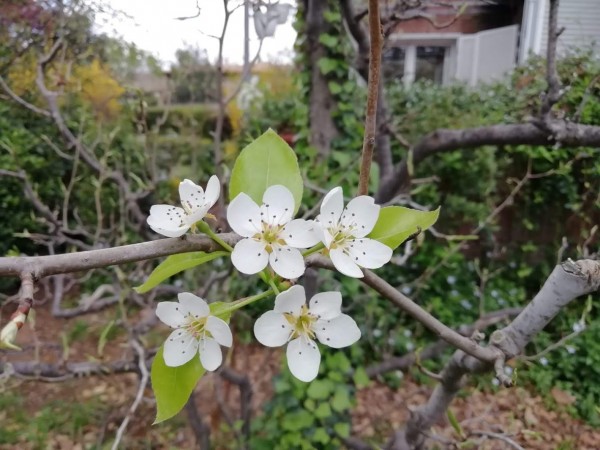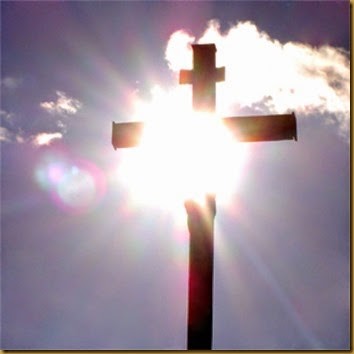
Happy Easter of Resurrection! Today we are starting the longest of all liturgical seasons, 50 days that offer a unique opportunity to savor and make ours what we have just celebrated. Jesus, alive and present among us, is the reason of our joy; otherwise, our faith would be void.
In this season of Easter we celebrate the great feast of the Love of God, that has been bestowed on us with no merit of our own, as the Gospel of John states clearly: “For this is how God loved the world: he gave his only Son” (John 3, 16). We recognize, as our liturgy points out, what God has done for us, out of love, by offering us salvation in his Son, even in death. Easter is a feast because we celebrate the gift of life that comes from God, and which none of us have merited or achieved of our own.
Our main attitude in this season of Easter and, therefore, in Christian life, has to be gratitude: being and living in thankfulness is a virtue that should define our lives, signaled by Faith, for, while embracing the experience of Easter, we recognize that life is always a gift. This is the very essence of our faith, as the Easter proclamation goes: “Our birth would have been no gain, had we not been redeemed. O wonder of your humble care for us! O love, O charity beyond all telling!”
In this season, more than ever, we celebrate the love of God in our lives. It is only fitting to ask ourselves if the way we live our faith reflects this gratitude for the gift we have received or, if more often, we go back to religious practices where we try to please God with our worship, our piety or even discipline to show him our love. A truly Easterly faith will not try to “gain” God’s love, for redemption can only be understood as the free outpouring of divine love, and the only way to respond to this gift is gratitude, the truly Easterly virtue of Christian life.

Several years ago, during a funeral in the streets of Sabana Yegua (Dominican Republic), the daughter of the deceased confronted me during my homily with the following words: “I am scared for my dad. Do you really believe this?” I should say that during the homily I was trying to comfort the family by sharing with them the essence of our faith: the Resurrection. I was telling them that by faith we believe that Jesus, after his death, rose and, in his Resurrection, destroyed death and gave us eternal life. All of us who are baptized in Christ enjoy this Grace. On that sunny day I was faced for the first time in my life with the question: why do I believe in the Resurrection?
To answer this question, we must start by reflecting and exploring the feelings that the group of disciples experienced after Jesus’ tragic death on the Cross. The Cross was a devastating event that shattered the hopes of those who walked with Jesus as disciples. Jesus’ detention scattered the disciples (Mt 26, 56). The hours after the Crucifixion must have been agonizing, with the disciples not knowing what was going to happen to them, not knowing what could be done, not knowing what to think. The time before the Resurrection was one of fear and anguish, with no certainty that Jesus’ promise would be fulfilled. Anxiety and despair were common emotions for the disciples. Many of us go through life with anxiety and anguish because we don't really know what the future will bring us, and the uncertainty scares us.
Matthew’s Gospel tells us about the decisive moment in which Jesus is revealed to the women as a new man (Mt 28, 1-10). These two women, in their anguish, go to the tomb, moved by the hope of confirming the Lord’s promise. They want answers to their questions. They want to verify that all is not lost. They want to see the grave. Once in the tomb, the angel encourages them not to fear. The power of the angel’s words gives them hope. In that moment of pain, loss, despair, and fear, the first thing they hear is, “Do not be afraid”, followed by the news that Jesus is alive and is on his way to Galilee. He is heading to the place where it all began and where things were more homey, friendly, familiar, and exciting for the group: Galilee, a land far away from the intrigues of the religious institution in Jerusalem; Galilee, where everything was shared in the open, nothing hidden, unlike the last week in Jerusalem. “Do not be afraid!”—those are words of encouragement.
The women reacted by running joyfully to the disciples, impressed by what they have just seen and heard. At that moment they confirmed Jesus’ promise—His Resurrection. There is no time to waste, they must announce the good news. Once they run away, wanting to share Jesus’ Resurrection with others, they meet Jesus himself, and the teacher's words are the same: "Do not be afraid". And once again comes the announcement that they will meet in Galilee. The Resurrection shatters any fear. Believing in the Resurrection gives us courage and helps us have full confidence in life. This certainty fills us with joy and hope.
I would have liked to respond to the young woman who expressed her fear with the words of the Lord: "Do not be afraid." I would have liked to have conveyed the confidence that the angel gave to the women who ran with joy in haste to announce the risen Lord. The truth is that I only answered, "Yes, I fully believe it." If I were to see her again, I would add, "I totally believe it because the Resurrection gives me courage to live life without fear and fully trust in the Lord's promise of a joyful life."

The Easter season is the longest of all the seasons of the Church, fifty days dedicated to the contemplation and meditation of the experience lived by the disciples of Jesus, men and women who followed him and who believed in his preaching, discovering the Jesus himself resurrected after his death on the cross. During this time, they got to know him and recognized him in different ways, always with the initial doubt about his identity, since it was the same Jesus with whom they had walked and eaten―and at the same time it was a new and different Jesus.
We Christians profess that Jesus defeated death and reached the definitive life of God in which he remains eternally. Alive, it manifested itself to his disciples, and alive they experienced it in the different encounters that the Gospels describe. Alive, but different… because life changes, always, and it changes even more in those who have experienced death. Nature clearly shows us that all living beings are subject to permanent change throughout their life cycle, and that we can observe and recognize the transformation that occurs in the natural world around us, which was mentioned so many times by the Jesus himself in his parables, such as those of the sower, of the vineyard, or of the fig tree and its fruits.
Saint Paul also speaks of the transformation that entails the transition between life and death, using an image of nature: “The seed you sow does not germinate unless it dies. When you sow, you do not sow the full-blown plant, but a kernel of wheat or some other grain” (1 Corinthians, 15:36-37). Life, therefore, is characterized by change; it is what does not change and remains the same that is dead. In daily, everyday life, the changes are perhaps less striking, but they are always present, because in human relationships, for example, such as friendships, we learn that everything changes over time: relationships are strengthened and developed, while others decrease or disappear.
Love, which is life at its best, confirms this dynamic of transformation: love that is alive is constantly changing. Pope Francis says it very well in his letter on the joy of loving: “A love that fails to grow is at risk.” (Amoris Laetitia, 134). Love grows or decreases, but like all living reality, it is subject to constant change, it does not remain the same by itself, and it needs to be nurtured in order to evolve.
The resurrection, therefore, is the manifestation of a life that will continue to grow without limits, and that will take on multiple forms, because in its development it will never stop changing. The encounter with the risen Jesus takes as many forms as there are people who have experienced it, and it will always be new and different, because He is alive. For the followers of Jesus, assuming his resurrection is to live embracing the permanent change in our own lives, discarding the old, open to the permanent novelty of God. “Clothe yourselves, therefore, with the new man” (Ephesians 4:24), exhorts Saint Paul several times to his followers.
A resurrected Christian community, and a resurrected believer, must distinguish themselves by being alive, that is, constantly renewing and changing, thus responding to the needs of their own life and that of the world around them. Saint John Henry Newman said with great precision: “In a superior world it can be otherwise; but here below, to live is to change, and to be perfect is to changed many times.” To live is to change—and by changing, we manifest the life that beats within each one of us. The fear and resistance to change that people, institutions and societies express so vehemently is, ultimately, a fear of life itself, of being alive. Jesus overcame that fear forever, and with his resurrection he taught his disciples, and he teaches us, to live changing, many times.

Happy Easter! Jesus has risen!
This great feast, center of the liturgical year and of our entire Christian faith, invites us to seek Jesus among the living. Let us stop looking for him among the dead, in everything that destroys and oppresses, where there can be no green shoots of hope!
Jesus, alive among the living, is not to be found in violence, which only generates more violence, and blindness, and death, discouragement, and sadness.
Jesus, living among the living, is not to be found in contempt, in situations where some look with disdain at others because of their race, their social status, their gender, their orientation, their past...
Jesus, alive among the living, is not to be found in those contexts of privilege and inequality where a few enjoy the goods that belong to all.
Jesus, alive among the living, is not to be found in the indifference that kills, in the indifference because of which the pain of those living on the margins of society becomes invisible, as if it did not exist… as if they did not exist!
We must look for Jesus, alive among us, in the gestures of peace and reconciliation of those who have understood that war, brute force, insult and slander are never the way.
We must look for Jesus, alive among us, in those who welcome everyone with open arms, whoever they are, wherever they live, however they love...
We must look for Jesus, alive among us, in the efforts of so many people to build groups and communities of the Gospel, where fraternity is not an empty word, where synodality and walking together is the formula to learn to listen to each other and value the richness of plurality.
We must look for Jesus, alive among us, in the sensitive hearts that are moved, over and over again, with the pain of the poorest, the Father's favorites.
The followers of Jesus, in short, are people who strive, always, and sometimes with a stubbornness bordering on obstinacy, to look for signs of new life in the world, aware that the strength of the Risen One always ends up making itself present wherever there are human beings open to the life-giving, liberating and renewing Spirit of God, who raised Jesus from the tomb.
Let's celebrate Easter by finding Jesus… Alive in our midst!
We wish a blessed Easter to all the readers of this blog, friends of the Community of Saint Paul.
Easter Sunday: The scar
One finds a scar on the skin of Time.
Time, that old fool, still ponders it, perplexed.
What happened, that Sunday?
The punctual affliction that
Had never failed to arrive
In the lives of microbes, crabs, and lizards;
And iguanas, tortoises, felines, dromedaries and camels,
And this new biped that now thinks
And knows of love. Yet
That Wound, victor of every battle,
That particular sunny Sunday,
Was defeated.
Its defeat left a scar
On the smooth skin of Time.
And the eternal dance of Creation
By light, was split in two.

The title of this article is a question that not only Mary Magdalene who came to anoint Jesus’ body on Sunday morning asked herself (John 20:1-9), but it is also a question that is in our minds right now. When public masses where suspended in many dioceses around the globe, many people ask themselves what are we going to do if we cannot receive communion? And after celebrating the mass with an empty church some of my friend priests were explaining how it was indeed a staggering experience. The actual situation of the Church in times of the COVID-19 is affecting everyone in our parishes. With no public masses, both priests and laity are struggling to find ways to continue feeding their faith. No doubt the measures taken have seriously affected the spiritual needs of numerous people. But if during the pandemic you only worry about how to deal with the quarantine without the Eucharist and with empty churches, consider yourself lucky. The quarantine is making numerous people ask themselves not only how to satisfy their sacramental needs, but also what they are going to do without the bread and with empty stomachs. Entire families that depended on their daily work to survive are now in dire need because they cannot go out to work. My intention is not to create a dichotomy between the sacramental and the physical needs. Both are essential for people of faith. But the present situation and the readings for Easter Sunday have made me reflect how the absence of the body described in the resurrection narrative can take a special meaning, especially for those who are now suffering hunger because of the pandemic.
When all this started, I saw many creative ways in which pastors and parish staffs reached out to parishioners. Social media and streaming services became useful to ensure that parishioners felt connected to the celebrations and that their spiritual life was being taken care. I have also seen many efforts by religious and non-religious groups to ensure that people do not go hungry during the pandemic. Parishioners and priests who I personally know have organized themselves to deliver bags of food for those whose daily income has been affected by the pandemic. But even after COVID-19 there will be people who ask this question every day: what am I going to do without bread and with an empty stomach? I believe this current situation has shown we can be ready to act and help to provide. The Church has shown that during the pandemic, it can provide for both the spiritual and the physical needs of those in need.
After the crucifixion, when she saw that there was no body but an empty tomb, Mary Magdalene run to Peter and the other disciple thinking the worst: the body is gone forever, and they will never find it. A reasonable deduction when all hope is gone. We are invited during this time to continue hoping and believing, that after the pandemic, we will continue to receive the Body of Christ. The reaction of Mary Magdalene is the reaction of someone who longs to see Jesus again; a reaction many of us may also have now in a moment of spiritual hunger. As some of us share with her our hunger for the Lord, let us not forget, while we wait for him with hope, to satisfy the hunger of those who lack bread now because of COVID-19. Let us not forget that “the joys and the hopes, the griefs and the anxieties of the people of this age, especially those who are poor or in any way afflicted, these are the joys and hopes, the griefs and anxieties of the followers of Christ” (GS1).
There is a crack in everything, that’s how the light gets in.
Leonard Cohen (Anthem)
Traditionally our faith as believers and Christians, specially within the Catholic tradition, is defined and understood as a collective event. The Church, the community, the sacraments are indicators of the importance of the collective character of our faith. Even the hermit has a collective faith: the “Robinson Crusoes of faith” do not exist.
However, when we talk about the resurrection, we tend to strip the faith of its social content and we retreat to a more intimate dimension; the Resurrection seems to be confined to a personal dimension, an individual event inaugurated by Jesus. Beyond theological considerations, the following is a reflection on the meaning of the resurrection from a collective point of view. The purpose of these lines is extremely modest: to see how at a sociological level there is an association between death and resurrection, and to look at what is, then, the meaning of the latest.
Jesus’ passion was not only one man’s torture, it was not only the indescribable physical and psychological pain of dying on the cross. The unbearable torment of the cross was also a dramatic collective event. The crucified Jesus was a tragedy with deep social implications. It was precisely from this collective debacle that the nascent, frightened and weak Christian community began to live the experience of the resurrection, to gain awareness, courage, strength, and conviction; It was there that the cross became not only an instrument of torture but a symbol of life, a sign of a common struggle. The passion as a social phenomenon is somehow necessary for the resurrection of a people or a community.
In the same way that Jesus made the Passover from death to the life, analogically we can observe how oftentimes a reprehensible and unjustifiable act of violence or a social injustice are capable of bring about new life.
We don't have to look very far to find some dramatic examples of this: last February 14, we witnessed a shooting in a USA school, another tragedy to add to the heartbreaking statistic of gun victims in the country. That awful event has started a popular student movement to demand changes in the regulation of the acquisition and possession of weapons.
Another example is the recent announcement by Pope Francis about the canonization of bishop Oscar Romero of El Salvador, murdered on March 24, 1980 while celebrating the Eucharist. His death helped the growth of popular movements against political and military tyrannies across South America, and elsewhere.
Still going back in time, another example was the horrific killing of a young Emmett Till in 1955, in the State of Mississippi. From the pain and rage of this racially motivated crime, African Americans responded with new strength through the Civil Rights movement in the USA.
Only five years later, in the Dominican Republic, the Mirabal sisters, three women who dared to confront the tyranny of Trujillo’s regime, were killed: it was November 25th, 1960. To honor them, that date was later chosen to celebrate the International Day for the elimination of Violence Against Women, and since then there is a growing awareness about women’s abuse, becoming, 50 years later, one of the basic demands for women’s right.
More examples could be added of people who have led to a collective resurrection through their own passion and sacrifice, such as Mahatma Gandhi, with his non-violent struggle for India’s independence and peaceful co-existence between Hindus and Muslims, or Harvey Milk, assassinated in 1978 for his political activism defending the rights of homosexuals in San Francisco. These are well known examples. There are many anonymous passions, only known and experienced at the local level, or within a group or even in a family. But in any case, they still bring about the mobilization of that group.
All these passions, regardless of how well-known they are, raise the conscience of a group or a community. It’s a jolt that wakes up sleeping consciousness, shakes up apathy and takes us out of our comfort zone, and moves us to political or social action (the resurrection). It does not need to be revolutionary or violent. The collective being moves slowly, but the initial spark, the initial movement, it’s almost always traumatic (a passion).
All collective passions, like Jesus’, dramatically reveal the cracks of the social structures, that are often hard with the weak and accommodating with the strong. But through these passions, in turn, there is always the possibility for a new resurrection, a movement of light, of hope and change. The Resurrection of Jesus is a permanent invitation to us to turn social injustice, exclusion and intolerance into life, hope and social integration.
At the beginning of Lent we meditated on the contingency of our existence, about the teachings of the phrase, “You are dust, and to dust you shall return”. We pondered the benefits of being well aware of our finite nature. Today, on the great feast of Easter, we seek the road to the Resurrection.
Easter is the celebration of new life, new creation, rebirth, transformation; it is happiness, interior peace, profound joy. Perhaps in life we don’t seek these goals following a straight linear road, but rather through a cyclical route, transported by the waves of life. We go forward step by step, not without stumbles and setbacks, maybe taking some detours... pursuing a slow spiral, and we do it embracing the cross. That personal cross, those limitations that we are conscious of, those hidden selfish acts, the jealousies and lazy habits that betray our lofty goals; it is simply necessary to bear those crosses. There is no way around it: As the evangelist says, “Take up your cross and follow me.” A key to the cross is accepting, embracing, gathering up everything that is difficult to bear. Accepting, for instance, how silly we can be at times; accepting the deceptions in which we entrap ourselves, like in the web of a spider; accepting the illness that reveals to us how human and fragile we are; accepting the dependence on others for so many things; and accepting and embracing the imperfection of our world, of the humanity that God created free, with all its miseries and vanities, capable of the most beautiful gestures and the worst atrocities.
Once we have accepted all of this, once we have embraced the cross, with the strength and grace of God, we lend the Father a hand in His work, as His beloved children, as His hands, His feet and His eyes. It is then when we can draw closer to His Son, in our attitudes, our tenderness, in our indiscriminate acceptance of others. It is then when we can draw closer to Jesus in our fight against injustice, against the merchants in the temple, against the hypocrisy of the Pharisees, against the indifference of the Levite and the priest toward the wounded man. It is then when can draw closer to Jesus as He prays in the garden, asking for God’s will, and not our own, to be done.
It is then when we discover the joy of the Resurrection, when hope is reborn, when solidarity reigns. It is then when profound happiness grows, when fear ends and love is renewed. It is then when we live the Feast of the Resurrection.







